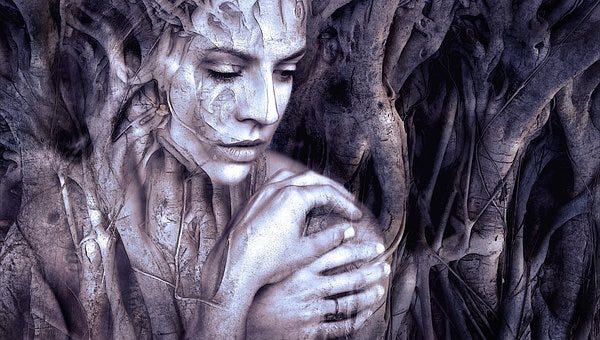
This article is the latest in a series on the theme of whether we can find a new mythology, a common visionary story, to unite humanity in an attempt to solve the world’s problems. To put what follows into context, please see the previous article. (For a guide to the whole series, see under Mythology near the bottom of the Blog Index page.)
===============================================================================================
The science of the new mythology should be based upon the worldview of quantum physics which, in the words of Keiron Le Grice, “paved the way for the emergence of the new paradigm sciences emphasizing holism, organicism, complex causality, field theories, nonlocal connections…”¹.
Some specific scientific ingredients, which are merely catching up with the standpoint of longstanding spiritual traditions, would therefore be:
- The Universe is not a machine, as perceived by ‘Enlightenment’ scientists, rather a living organism. On this point I can do no better than quote D. H. Lawrence: “We and the cosmos are one. The cosmos is a vast living body, of which we are still parts… Now all this is literally true, as men knew in the great past, and as they will know again”². One obvious consequence of this viewpoint is that the universe is not pitilessly indifferent to humans, as claimed by Richard Dawkins and Steven Pinker. How can the universe be indifferent to us if it is an organism of which we are a part?
- Our home, planet Earth, is therefore also a living organism, usually known as Gaia, the Greek goddess. James Lovelock’s Gaia Hypothesis would therefore become a scientific cornerstone of the new mythology³.
- The Interconnectedness or the Oneness of Life — also a consequence of the first point, since the Universe is one great superorganism. This has been recognised by quantum physics. Fritjof Capra talks about “a perception of reality that goes beyond the scientific framework to an awareness of the oneness of all life, the interdependence of its multiple manifestations, and its cycles of change and transformation”⁴.
All this suggests the need for a revival of the worldview of animism, which has been rejected by Enlightenment science. There is an interesting book, available free online, called Towards an Animistic Science of the Earth by Stephan Harding, who says in his introduction: “If we are to have any chance of surviving the looming catastrophe that science and technology have inadvertently helped to create we will need more wisdom, not more analytical capacity… We now urgently need to develop a new approach in science that integrates analysis with wisdom, fact with value, and nature with culture… by replacing our demonstrably unwise (and until recently, unconscious) assumption that the world is an inert machine with the arguably wiser and more accurate metaphor that the world is a vast animate (and hence ‘sentient’) being”.
Quantum physics has inspired the new worldview outlined above. One problem that we currently face, therefore, is that the quantum revolution has not yet sufficiently penetrated the public consciousness. As Deepak Chopra said in a recent article on Medium.com⁵:
- “Quantum mechanics is considered the most successful scientific theory of all time, but its effect on everyday life — or at least everyday thought — has been marginal”.
- “The general public has a vague acquaintance that quantum physics changed how science views space, time, matter, and energy. What escapes general notice, however, is the revolution that followed the quantum revolution”.
According to Chopra, the essence of this revolution is contained within the world wholeness: “The answer advanced by more and more scientists is ‘wholeness’. Since space, time, matter, energy, and everyday logic aren’t truly fundamental, it makes sense that whatever controls space, time, matter, and energy must be the universe’s overriding reality. Wholeness exerts a force, call it ‘the power of one’, that goes beyond physical forces. Or to put it another way, no combination of physical forces can be used to explain how the whole maintains and organizes itself”.
The quantum revolution is therefore suggesting some transcendent organizing power, which is interesting from a spiritual point of view. The new mythology needs to stress and promote this quantum understanding, to help bring it more to public attention.
Some specific claims of materialist science that the new mythology should reject are:
- that matter is the fundamental reality
- that the brain generates consciousness
- that the self is an illusion
- that the universe is completely comprehensible through the laws of chemistry and physics
- that the evolution of life can be explained by nothing more than natural selection acting upon random genetic mutations
- that the Big Bang is indisputably the explanation for the beginning of the universe.
(I have already written several articles on these themes. See the Articles Index and Blog Index pages.)
Click here for the next article in the series.
=============================================================================================
Footnotes:
1. The Archetypal Cosmos, Floris Books, 2010, p36
2. Apocalypse, Martin Secker, 1932, p45
3. See Gaia: A New Look at Life on Earth, 1979, revised edition 1995, OUP
4. Tao of Physics, Flamingo, 1992, p358
5. The Power of One https://medium.com/@DeepakChopra/the-power-of-one-251d0792efcc